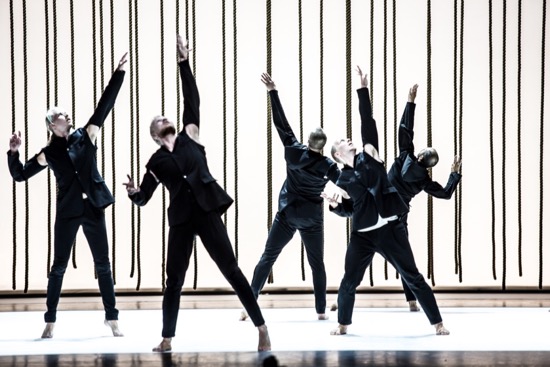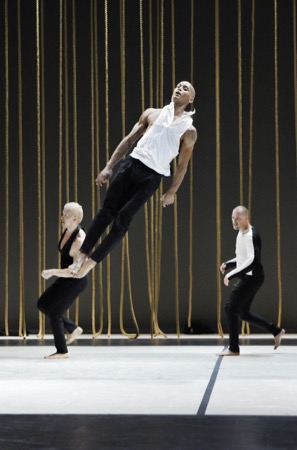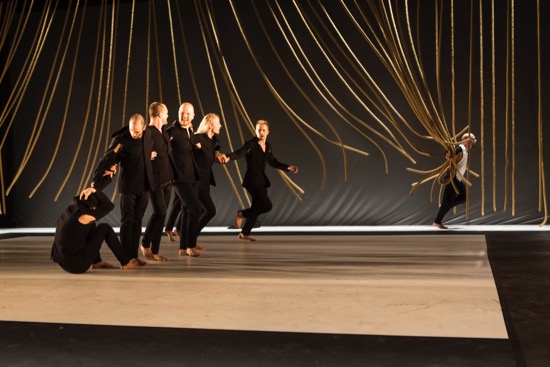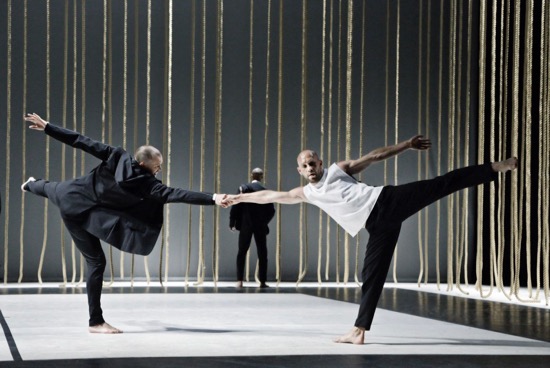Tero Saarinen Company performs at the Joyce Theater.

Five men of Tero Saarinen Company in Saarinen’s Morphed. Photo: Mikki Kunttu
Who are these men? I can tell you their names: Ima Iduozee, Leo Kirjonen, Mikko Lampinen, Jarkko Lehmus, David Scarantino, Eero Vesterinen, Heikki Vienola (have you guessed that almost all of them are Finnish?). However, seeing them onstage at the Joyce Theater in Morphed (2014) by the fascinating choreographer Tero Saarinen, you would not at first have perceived them as individuals. Teemu Muurimäki has dressed them identically in slim pants and elegantly tailored jackets with the underarm parts cut out. The jackets have hoods.
Sitting in darkness, we hear the sound of feet striking a floor. The curtain slowly rises to reveal the seven hooded men walking on individual paths. Designer Mikki Kunttu has trapped them with rows of thick, yellow ropes—a single row hanging at the back of the stage and two rows on either side, each of the latter with a pathway between them. You can imagine the rope curtains as confining, almost as prison bars, and the opening of Morphed can affect you like a puzzle to be deciphered. The men walk only on straight trails running from the front of the stage to the back and from side to side. Given the choreography’s right-angled changes of directions, you can almost see them as tracing different-sized boxes within boxes. The dancer who holds down center (he turns out to be Vienola, the tallest cast member) steps around a box about two-paces square. Since the performers must have started at different points onstage, this clockwork vision that Saarinen has created is far more complicated than I have made it seem.

Ima Iduozee aloft. Behind him: former cast member Saku Koistinen (L) and Jarkko Lehmus. Photo: Heikki Tuuli ©
It is also strangely disturbing; although the pattern is extremely orderly, collisions could easily happen (one almost does). Traveling on a white floor topping a larger black one, the men occasionally freeze at the same moment. The pattern expands slightly in space (or seems to); the walk begins to resemble a march. Then, with a growl, the music begins. It’s Esa-Pekka Salonen’s Concert etude for solo horn, one of the three works by Salonen that accompany Morphed. An individual breaks out of the pattern briefly. Diagonal paths appear; the pace quickens; a step becomes a lunge. The men congregate on one side of the stage, and, at an orchestral crash, push their hoods back.
Salonen’s dramatic Foreign Bodies for orchestra thaws the men’s regimentation. We can begin to notice them as individuals collaborating, even when they move in unison or contrapuntally in two squads. Although these seven are superb dancers, we rarely see their movements as display. A leap, for instance, may appear as an attack, a fall as succumbing. A certain forceful gesture may resemble hurling an object or reaching for something too distant to grasp. A man covering his ears with his hands or rubbing his face or staggering or collapsing is inherently dramatic, but Saarinen formalizes such gestures by not letting them lead to something. There’s no “story” beyond what the movement tells us. Over the course of the dance, we see the men as aggressive, driven, tender, or playful in overlapping ways. Hooding themselves or uncovering their heads may indicate changing states of mind. They scan their environment and what lies beyond it. As they become more intimate with each other, they become more known to us.

Tero Saarinen Company in Morphed. Photo: Günther Gröger, ©grox
This world to which we’re privy changes with their exertions; with Kunttu’s expert, subtly varying lighting; and with the last piece of music: Salonen’s Violin concerto. Some of the men reappear sleeveless or without jackets or bare-chested. The ropes at the back lose their rigidity, beginning when Lampinen grabs some of them into a bundle and twists them around himself; he lets them go, and they fly out in an aerial whirlpool. And eventually, the ropes—swaying, swirling— create images of an uncontrollable, possibly dangerous place. When the dancers grasp hands and swing in a chain around the stage, they echo that volatility.
Some of the performers occasionally wait or rest, while others move more actively, and our eyes respond to the loosening of their original restrictions. We notice how powerfully Lehmus struggles alone, how intricately Scarantino expresses himself—solitary or in company with Kirjonen and Lampinen (who at one point carry him away in a standing position as if transporting a statue). We’re startled when Kirjonen suddenly launches himself from an offstage spot we can’t see and appears before us about two feet off the ground before collapsing. Now Vesterinin catches our gaze, now Vienola. Iduozee’s extraordinary moments by himself reveal a sinuous fragility within strength; although he started his career as a prize-winning breakdancer, in this solo he suggests the exploratory tentativeness of a wading bird. The seven all have stories we can sense but don’t need to know.

Jarkko Lehmus (L) and Ima Iduozee in counterbalance; former cast member Jussi Nousiainen at back. Photo: Heikki Tuuli ©
If you compare the ending to what you saw an hour ago when Morphed began, something has indeed “morphed,” softened. Anonymity and almost robotic behavior have fragmented into individual or collaborative assertions—some gentle, some rough—that shape this onstage image of community. For a few moments, only three people may be onstage, one hooded and at the back, one resting and watching, one dancing. Nor does the piece end decisively. As the music becomes very loud, the front curtain starts to descend. Very, very slowly. Behind it, the men are still busy, still striving, still changing. Silence. A thunder of applause.
